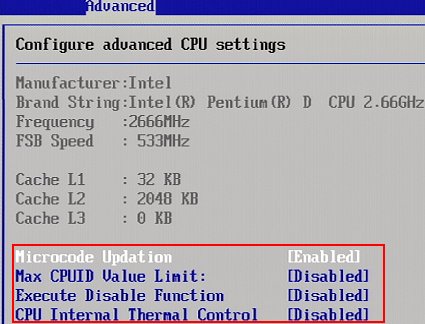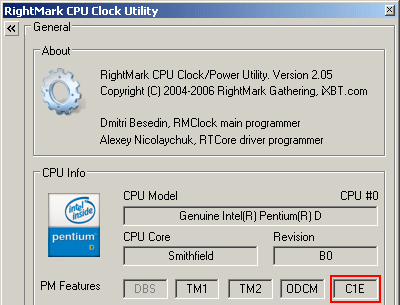A 4.1 GHz Dual Core at $130 - Can it be True?
Energy Saving Functions Lack C1E
By deactivating the C1E energy-saving function in the Pentium D 805, Intel bursts any hope of achieving the same functionality as the Intel Pentium Extreme Edition 965 with 266 MHz FSB. This makes it impossible to use a BIOS modification to achieve an "Enhanced Halt State" and thereby to raise the CPU multiplier any higher than 14x. This would have been an ideal configuration had it been possible: 14 x 266 = 3.73 GHz.
Restricted functionality means that only NX and Thermal Monitor 2 may be activated in the BIOS.
You can believe what the programs tell you. Although C1E is recognized, it can't be activated.
To be sure of our results, we put this CPU into various motherboards from Asus and Gigabyte. This let us test a variety of situations in which we could attempt to activate the C1E function. None of the motherboards with the most current BIOS versions would let us turn it on, however.
Intel's decision to turn the C1E function off is important for two reasons:
- All previous desktop CPUs with the C1E function couldn't lower their clock rates below 2.8 GHz. In the case of the Pentium D 805, its standard clock rate of 2.66 GHz sits well below this threshold. A C1E function would limit the device to no less than 1.86 GHz, which is an atypical value for Intel's desktop CPUs.
- Intel itself may have realized that this chip possesses extraordinary overclocking potential, and thus nearly the same performance as a fast Extreme Edition that costs over $1,000, In that case, it would have the same clock rate as the Intel Pentium EE 965 (14 x 266). Naturally, the Pentium D 805 only has half the L2 cache and no Hyper Threading, though.
Because the C1E function isn't present, this CPU also doesn't support SpeedStep. That's because these two functions are mutually interdependent.
| Energy saving functions | ||||||
|---|---|---|---|---|---|---|
| CPU Name | Row 0 - Cell 1 | Version | C1E | EIST | TM1 | TM2 |
| Pentium EE | 965 | C1 | X | Row 1 - Cell 4 | X | Row 1 - Cell 6 |
| Pentium EE | 955 | B1 | Row 2 - Cell 3 | Row 2 - Cell 4 | X | Row 2 - Cell 6 |
| Pentium D | 900 Series | B1 | X | Row 3 - Cell 4 | X | Row 3 - Cell 6 |
| Pentium 4 | 6x1 Series | B1 | X | Row 4 - Cell 4 | X | Row 4 - Cell 6 |
| Pentium EE | 840 | A0 | X | Row 5 - Cell 4 | Row 5 - Cell 5 | X |
| Pentium D | 805 | B0 | Row 6 - Cell 3 | Row 6 - Cell 4 | Row 6 - Cell 5 | X |
| Pentium D | 800 Series | B0 | X | X | Row 7 - Cell 5 | X |
| Pentium D | 800 Series | A0 | X | X | Row 8 - Cell 5 | X |
| Pentium EE | 3.72 GHz | N0 | Row 9 - Cell 3 | Row 9 - Cell 4 | Row 9 - Cell 5 | X |
| Pentium 4 | 6x0 Series | N0 | X | X | Row 10 - Cell 5 | X |
| Pentium 4 | 5x1 Series | D0, E0 | X | Row 11 - Cell 4 | X | Row 11 - Cell 6 |
| Pentium 4 | 5x0J Series | D0, E0 | X | Row 12 - Cell 4 | X | Row 12 - Cell 6 |
| Pentium 4 | 5x0 Series | D0, E0 | X | Row 13 - Cell 4 | X | Row 13 - Cell 6 |
| Pentium EE | 3.46 GHz | M0 | Row 14 - Cell 3 | Row 14 - Cell 4 | X | Row 14 - Cell 6 |
| Pentium EE | 3.40 GHz | M0 | Row 15 - Cell 3 | Row 15 - Cell 4 | X | Row 15 - Cell 6 |
| Row 16 - Cell 0 | Row 16 - Cell 1 | Row 16 - Cell 2 | Save Power | Row 16 - Cell 4 | Protection | Row 16 - Cell 6 |
Get Tom's Hardware's best news and in-depth reviews, straight to your inbox.
Current page: Energy Saving Functions Lack C1E
Prev Page Power Consumption Levels Top 200 W, Continued Next Page Risk-free Overclocking, Including Heat ProtectionTom's Hardware is the leading destination for hardcore computer enthusiasts. We cover everything from processors to 3D printers, single-board computers, SSDs and high-end gaming rigs, empowering readers to make the most of the tech they love, keep up on the latest developments and buy the right gear. Our staff has more than 100 years of combined experience covering news, solving tech problems and reviewing components and systems.
-
Tnias I am quite interested in your post regarding the D 805. Considering that it is now available for around $60.00 (03/20/09), it still sounds like a steal. We just upgraded our Adobe CS2 software to the new CS4 Master Suite, which caused the need for a graphics card upgrade. We have an nVidia GeForce GTX 260, but haven't installed it because our computer is a HP Media Center PCm7350n computers each with a 2.8 GHz CPU on a ASUS P5LP-LE mobo. Your article seemed to imply that there is software available that might adjust the clock from inside windows and we are wondering if it can on that mobo or if we will have to get a different mobo. If so, we are wondering what might be our most cost effective but stable options. We are certainly going to need a new power supply for the GTX 260, which requires 525 Watts. We are looking at just putting in PC Power & Cooling’s, Silencer 610 EPS12V power supplyand letting it go at that, but we are also thinking about upgrading the CPU and mobo if necessary.Reply
Of course, we would like to keep the cost down as much as possible.
We have no idea where the best bang for the buck will be. For us a stable system is more important than blazing speed. Thus, the HP's worked fine for what we originally got them for; it’s just that our graphics and video production software are forcing upgrades in speed and power.
The D850 chip sounds incredible and the power supply we already have to get will handle overclocking that chip. It even sounds like that chip will work in the existing mobo if we can find a way to change the clock speed from inside windows instead of from the BIOS. HP BIOS does not allow adjusting the clock speed in the BIOS but can't BIOS just be changed as well; isn't it just an EPROM?
Anyway, even if we opt for changing out the mobo for another case compatible Asus mobo, we still have to answer the question of which board and chip combination will give us the most stable service for the least cost.
Any ideas that might help us plan the most appropriate upgrade and the least cost? -
amnotanoobie TniasAny ideas that might help us plan the most appropriate upgrade and the least cost?Reply
With the price of components that you need to make this run stable, and the amount of electricity that this would use, a cheap Core 2 and motherboard and DDR2 memory would cost you less in the long run.
Example:
Intel Pentium Dual Core E5200
Kingston DDR2 2x2GB 800MHz
Gigabyte G31M-ES2C
This should cost less than $200.


